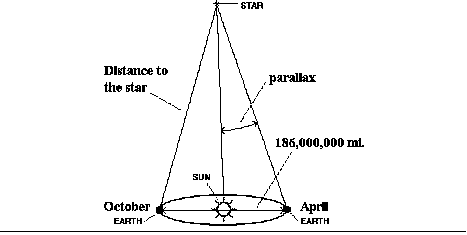Yerkes Observatory Log: Measuring Stellar Distance
Jack Kramer

He did this by photographing a relatively nearby star, then carefully studying the photographic plate to determine its exact position against the background of fainter -- and more distant -- stars. Six months later when the Earth had traveled 186 million miles to the opposite end of its orbit, he again photographed the same star. The shift of the star against the other background stars could be used to compute the star's distance. In effect, the Earth's orbit became the baseline, as illustrated below.
This was extremely exacting work. Not only did he have to spend long nights taking pictures of the stars, but Schlesinger's days were spent measuring tiny star images on photographic plates using a microscope and micrometer. By the 1920's, the combined efforts of Schlesinger and astronomers at other large observatories had increased to about 2200 the number of stars whose distances were known with reasonable accuracy.
Another staffer at Yerkes, Walter S. Adams, was using a spectrograph to measure the radial velocity of stars (toward or away from the Earth). Years later at Mount Wilson, Adams developed the method of studying the relative brightnesses of spectral lines to deduce the temperature and pressure within stars. By comparing the brightnesses of stars of like characteristics, thousands of stars were added to the list of those whose distances are known with reasonable accuracy.





